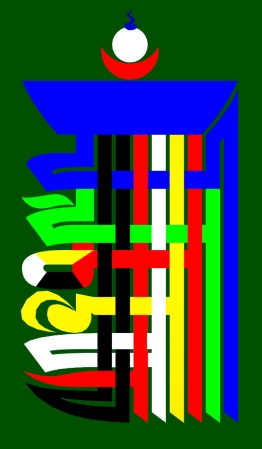 |
Kālacakra monogram
The "one with ten powers"
One of the best known symbols of the Kālacakra system, indeed of the whole Vajrayāna, is the image on the left, of the seed syllable (snying po), or monogram, of Kālacakra (rnam bcu dbang ldan). This consists of seven individual syllables combined together, in a stylised version of Indian Lantsa characters (ornamental script, or Ranjana script.)
In addition there are three other components to make a total of ten elements within the image - these are the crescent (usually red) known as a visarga, the disk or doughnut shape (usually white) known as a bindu or anusvāra, and a deep blue nāda, or wisp with three twists, at the top.
There is a less well known, but arguably as important form: click here for a description of this other version of the Kālacakra monogram, associated with generation process meditation.
Below, the combined syllable is broken into its constituent parts to show the form of each. The individual forms shown are not the normal forms they would take, but the shapes required in order to combine together in the overall figure.
The description that follows is based mainly on the work by Banda Gelek ('ba' mda' dge legs), called: "dpal dus kyi 'khor lo'i yang snying rnam bcu dbang ldan gyi don bshad pa rin chen sgron me". This text starts by discussing the basic description and symbolism of the monogram given in the Vimalaprabhā, as commentary to the fifth verse of the first chapter of the Kālacakra Tantra. Some further material here has been taken from the Vimalaprabhā. Also, as there are some differences between the various Tibetan traditions, use has also been made of the great commentary on the Vimalaprabhā by the Gelugpa writer, Khedrupje (mkhas grub rje): "dpal dus kyi 'khor lo'i 'grel chen dri ma med pa'i 'od kyi rgya cher bshad pa de kho na nyid snang bar byed pa".
 |
 |
 |
 |
 |
| Nāda | Anusvāra | Visarga | Ha | Kṣa |
 |
 |
 |
 |
 |
| Ma | La | Va | Ra | Ya |
This use of the term visarga for the crescent shape is unusual, and seems to be exclusively used in this Kālacakra context. What may be intended here is the combination of the drop and crescent shapes as a variant on the normal anusvāra, known as the anunāsika. In his grammar book, Arthur Macdonell describes the anusvāra as an unmodified nasal following a vowel, and the anunāsika as a variant on this, indicating a nasalised vowel. This seems similar to Banda Gelek's interpretation, of a combination of nasalisation and aspiration – the use of both the nose and the mouth.
The basic symbolism as given in the Vimalaprabhā describes the origination of the ten letters (more properly, letters and parts of letters). This is based on the fifth verse of the Kālacakra Tantra: "From the vajra-kāya, described as ten existences, body, awareness, space, wind, fire, water, earth, stable, moving, and the gods unseen and uncreated, originate the site of creation of mantras, and Lord of Men, there again are released. In this way one who understands this properly is not a beast and their mind is free from conceptualisation."
In this verse, the vajra-kāya, the pure aspect of the body, is described in terms of ten aspects of existence, and that these are essentially (associated with) the sites of articulation of different sounds. The Vimalaprabhā states that "body is the Moon free from obscuration; awareness is the Sun free from obscuration; space is the element of space free from obscuration, and similarly for the elements of wind, fire, water and earth. Stable is the realm of stability free from obscuration, which has the nature of the five elements; moving is the realm of individuals free from obscuration, which has the nature of the six elements; the gods are unseen and uncreated, meaning that these gods are not seen and not created, in the formless realm only possessing the identity of consciousness..."
In this description, the "stable" realm refers to the outer physical world, consisting of the five elements, and the "moving", or "individual realm" refers to the animate world, possessed of the sixth element of awareness. The animate world is here considered to include the realms of desire and form.
The Vimalaprabhā then goes onto describe how from these various aspects of existence, certain basic sounds or syllables arise:
| Notice that the crescent shaped visarga is associated here with the sun, and is therefore usually red in colour, and that the circular shaped bindu (anusvāra) is associated with the moon, and is therefore usually white. They are sometimes called respectively the moon (because of the crescent shape) and the sun, and these names are clearly the wrong way around, and mis-leading. They were wrongly called by these names on an earlier version of this web-page, and they are often seen drawn with the crescent coloured white as if it were the moon, and the circle coloured red like the sun. I have not been able to find any description of either the monogram or its symbolism which actually gives the colours this way around. |
visarga – sun
nāda – space
i – wind
ṛi – fire
u – water
ḷi – earth
ma – inanimate
kṣa – animate
ha – formless realm
Some of these correspondences are straight out of Sanskrit grammar. For example, the site of articulation of a consonant or vowel is associated with an element, and of those above, the velar "a" (indicated by the "nāda") would be associated with space, the palatal "i" with wind, the retroflex "ṛi" with fire, the labial "u" with water and the dental "ḷi" with earth. The origin of the other associations is not so clear.
The Vimalaprabhā explains that these letters are to be written one on top of the other, and strengthened, so that the letters "ḷi", "u", "ṛi" and "i" become "la", "va", "ra" and "ya". They then form the Kālacakra monogram, "hkṣmlvryaṃ", with "kṣa" being written below and to the left of "ha", then "ma" below and to the left of "kṣa", and so on.
The structure of the monogram and its basic symbolism in terms of the outer physical world and the inner vajra-kāya have therefore been described in this verse from the Kālacakra tantra. In later verses describing the generation process meditation, these same syllables are also associated with the maṇḍala and other aspects of the meditation, and so the symbolism of the monogram covers all three aspects of outer, inner and other Kālacakra.
Symbolism of the Kālacakra monogram
Outer Kālacakra, the physical world.ya – black, the disk of the element of wind.
ra – red, the disk of the element of fire.
va – white, the disk of the element of water.
la – yellow, the disk of the element of earth.
ma – multi-coloured, Mt. Meru and the desire realm.
kṣa – green, the form realm.
ha – blue, the formless realm.
visarga – red, sun.
bindu – white, moon.
nāda – deep blue, with a triple twist, space.
Banda Gelek's association of the three realms here is a little different from that given in the Vimalaprabhā. Khedrupje also differs. He has, as one would expect:
ma – Mt. Meru.
kṣa – the desire and the form realms.
But more surprisingly he has "la" representing a multi-coloured lotus. The reason for this is not clear.
Inner Kālacakra, the vajra-kāya.
ya – For all beings, the soles of the feet, wind.
ra – The shins, fire.
va – The knees, water.
la – The hips, earth.
ma – The spine and the body, entailing the five elements.
kṣa – Between the throat and forehead, awareness element.
ha – The crown, space.
visarga – The rasanā (right) channel and the red element.
bindu – The lalanā (left) channel, and the white element.
nāda – The central channel and wind.
Also:
ya – The center of minor channels at the forehead.
ra – The throat centre.
va – The heart centre.
la – The navel centre.
ma – The minor channels in the joints of the body.
kṣa – The secret centre.
ha – The crown centre.
visarga – The rasanā channel.
bindu – The lalanā channel.
nāda – The central channel.
Khedrupje gives this second symbolism of the vajra-kāya, but with the following differences:
ma – From the navel to the secret place, or, the spine.
kṣa – The secret lotus where the three main channels meet.
ha – The central channel.
nāda – The bliss of awareness of the fourth state.
Yet another variation is given by Mipham (mi pham rgya mtsho), clearly following the commentary by Buton (bu ston rin chen grub):
ma – From the navel to the secret place.
kṣa – The secret lotus.
ha – The channel of faeces, through which moves the Apāna wind.
visarga – The channel of urine, through which moves the Apāna wind.
bindu – The channel of semen, through which moves the Apāna wind.
nāda – Not mentioned.
Other Kālacakra: 1. Generation process, the palace.
 |
ya – The purity of the element of wind, the essence of the disk of wind arisen from the awareness of Kālacakra.
ra – The purity of the element of fire...
va – The purity of the element of water...
la – The purity of the element of earth...
ma – The purity of Mt. Meru, the nature of the five elements.
kṣa – Above Meru, the purity of the four types of birth-site, a water-born lotus.
ha – Above the lotus, the purity of the external moon, the disk of the moon.
visarga – Above the moon, the purity of the external sun, the disk of the sun.
bindu – Above the sun, the purity of the external Rāhu (node), the disk of Rāhu.
nāda – The purity of the element of space which completely surrounds and pervades the entire maṇḍala, the essence of space indicating dharmodaya.
Khedrupje differs here with the last point. As the whole structure is a support, equivalent to the palace, the "nāda" represents the "supported", the deity Kālacakra, and by implication all the deities of the maṇḍala.
Other Kālacakra: 2. Generation process, the palace itself.
ya – The perimeter of wind, arisen from the accomplishing awareness of Kālacakra.
ra – The perimeter of fire, arisen from the equality awareness of Kālacakra.
va – The perimeter of water, arisen from the distinctness awareness of Kālacakra.
la – The perimeter of earth, arisen from the reality awareness of Kālacakra.
ha – The perimeter of space, arisen from the mirror-like awareness of Kālacakra.
ma – The garland of light, and the five-fold walls, which have the nature of the five elements.
kṣa – The deity lotuses on the podia in the palaces, arisen from the awareness of bliss and emptiness of the mind of Kālacakra.
bindu – The body palace, arisen from the body-vajra of Kālacakra, possessed of all positive characteristics.
visarga – The speech palace, arisen from the speech-vajra of Kālacakra, immeasurable speech.
nāda – The mind palace, arisen from the mind-vajra of Kālacakra, the (awareness of) bliss and emptiness.
Other Kālacakra: 3. Generation process, the deities.
ya – The essence of the one hundred and six deities of the wind-class, such as Amoghasiddhi, emanated from Kālacakra.
ra – The essence of the one hundred and six deities of the fire-class, such as Ratnasambhava, emanated from Kālacakra.
va – The essence of the one hundred and six deities of the water-class, such as Amitābha, emanated from Kālacakra.
la – The essence of the one hundred and six deities of the earth-class, such as Vairocana, emanated from Kālacakra.
ha – The essence of the one hundred and six deities of the space-class, such as Vajrasattva, emanated from Kālacakra.
ma – Pervading all five elements and the awareness element, the nature of the six elements, Vajradhara and the chief deity Kālacakra.
kṣa – The text by Banda Gelek used for these notes unfortunately misses this syllable out, probably due to a scribal error. Possibly it symbolises the secret lotus of the consort, or the consort herself, Viśvamātā. Alternatively, this may symbolise the buddha Akṣobhya, adorning Kālacakra's head. He is green in colour and would be suitable here.
bindu – The awareness body (body-vajra) of Kālacakra.
visarga – The form of sounds and speech, the speech-vajra.
nāda – The mind of Kālacakra, the mind-vajra of bliss-emptiness, possessing the ten powers, the four fearlessnesses, and so forth.
Other Kālacakra: 4. Perfection process, the Six Yogas.
Before discussing the symbolism here, Banda Gelek first explains the relationship between the five paths and the two processes. Prior to practising the six yogas one first practises the generation process and traverses the path of accumulation (tshogs lam). Then, with the first five of the six yogas, the path of application (sbyor lam), and with the last yoga the paths of vision (mthong lam) and cultivation (sgom lam) are traversed. Having perfected the generation process, the awareness of the second yoga, dhyāna is obtained simultaneously with the attainment of the Vajrayāna path of application.
kṣa – The essence of Pratyāhara, the awareness of bliss and emptiness developed by contemplating the emptiness of appearances through bringing the activity winds into the central channel, thereby creating the experience of empty-forms. These are the ten signs, like smoke, and so forth.
ha – The essence of Dhyāna, the awareness of bliss and emptiness absorbed in the emptiness of the appearances of empty-forms through having perfected and increased the appearance of the empty-forms of the ten (types of) signs.
ya – The essence of Prāṇāyāma, the awareness of bliss and emptiness that arises once the ability has been developed to direct the empty-forms to such places as the centres and channels, have them remain there without moving, and this having been stabilised, bind the winds and dissolve the ten winds of the heart centre into the central channel.
ra – The essence of Dharāṇā, the awareness of bliss and emptiness that is developed by having stabilised the dissolution of the ten winds in the central channel, they dissolve into the drops (bindu) in the six centres, the winds and drops become merged, and the drops are bound without melting (emission).
va – The essence of Anusmṛiti, the awareness of bliss and emptiness that develops once the blending of the winds and drops and the binding of the drops have been stabilised, by the use of whichever is suitable of the three mudrās, through the blazing and melting within the central channel from the six centres arise the awareness of the radiation of all the various divine empty-forms (the classes of deities in the maṇḍala).
la – The essence of Samādhi, the attainment of the Vajrayāna path of vision and the realisation of the embodiment of the awareness of Kālacakra, the "body of maturation". This has the nature of a meditative absorption on such a form and awareness. Here, the emotional and conceptual obscurations are shed, and the paths of vision and cultivation and the ten levels are traversed.
ma – The essence of the five awarenesses of the path, similar to the five enlightened awarenesses.
bindu – The essence of body-vajra.
visarga – Speech-vajra.
nāda – Mind-vajra.
Khedrupje clearly does not like this type of analysis, considering it artificial. He writes: "As explained before, the four letters (la, va, ra & ya) represent the four main centres, and "kṣa" represents the secret lotus. By becoming proficient in the practice with these the tummo at the secret place blazes; this melts the white element at the crown, which descends and blends with the tummo creating the essence of great bliss. The visarga represents the blazing (red) tummo, the bindu the white seed that descends, and the nāda the essence of bliss developed in the mind.
He also mentions that in general, the ten letters represent the ten signs that occur in Pratyāhara and Dhyāna, the binding of the ten winds at the navel in Prāṇāyāma and Dharāṇā, the ten situations of desire in Anusmṛiti, and in Samādhi, the suppression of the movements of the ten winds, and the ten skandhas and elements (five each) freed from obscuration.
Other Kālacakra: 5. The goal, the nature of enlightenment.
ya – The essence of the deities of the wind-class such as Amoghasiddhi, the nature of the purification of the skandha of response.
ra – The essence of the deities of the fire-class such as Ratnasambhava, the nature of the purification of the skandha of sensation.
va – ...water-class ... Amitābha ... interpretation.
la – ... earth-class ... Vairocana ... form.
kṣa – ... awareness-class ... Akṣobhya ... awareness.
ha – ... space-class ... Vajrasattva ... consciousness.
ma – Kālacakra, embracing all classes.
bindu – The nirmāṇakāya of Kālacakra.
visarga – The sambhogakāya of Kālacakra.
nāda – The essence of dharmakāya: the svabhāvakāya and awareness-dharmakāya of Kālacakra.
Here, Khedrupje only gives two points: that the letters "haṃ" and "kṣa" represent the five and six letters of great emptiness; "haṃ" indicating the awareness of great bliss and "kṣa" the secret lotus of Mahāmudrā. The two of these in inseperable union purify of obscurations all the six elements, and this is indicated by the five and six letters of great emptiness.
Much the same could be said of the two syllables "e" and "waṃ". These are usually depicted either side of the Kālacakra monogram.
Last updated 29 March 2014.
Return to Home Page.